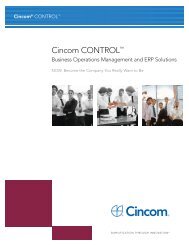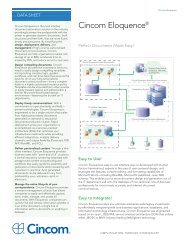Extract Utility User's Guide - Supra - Cincom
Extract Utility User's Guide - Supra - Cincom
Extract Utility User's Guide - Supra - Cincom
You also want an ePaper? Increase the reach of your titles
YUMPU automatically turns print PDFs into web optimized ePapers that Google loves.
MAXIMUM ( ⎡b/⎤⎢⎥⎣record-count )⎦RestrictionDescriptionFormatYou can use this statement only after a QUALIFIER statement. Specifically, thefollowing restrictions apply:♦♦♦♦Default b/After QUALIFIER(DIRECT). MAXIMUM is optional if doing a select where akey value was passed; otherwise, it is invalid.After QUALIFIER(SERIAL). MAXIMUM is optional.After QUALIFIER(SEQUENTIAL). MAXIMUM is invalid for primary files butoptional for related files.After QUALIFIER(INDEX). MAXIMUM is optional.Determines the maximum number of records that are written to the XTRCTOUTfile.1–9 decimal charactersOptions b/ <strong>Extract</strong> all recordsConsiderationsrecord-count♦♦♦♦Maximum number of valid data records (those that pass allother selection criteria) to extractIf you code MAXIMUM (b/), the function extracts all records. This isequivalent to omitting the MAXIMUM statement.If you code the MAXIMUM statement, you must put it before any RECORDstatement.The function includes in this count only valid data records that pass allother selection criteria. For example, if you specify an argument (via theCRITERIA statement), all data records must first pass the argumentvalidation before the function adds them to the maximum record counter.If you code a value that exceeds the total number of records in this file,the function stops at the end of the file.<strong>Extract</strong> <strong>Utility</strong> <strong>User's</strong> <strong>Guide</strong>, P25-9513-03 40Chapter: 5. Coding the <strong>Extract</strong> functionSection: Coding the UCL for the <strong>Extract</strong> function
















